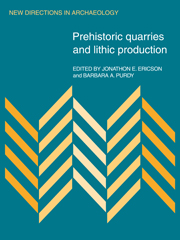Book contents
- Frontmatter
- Contents
- List of contributors
- Dedication
- Part 1 Introduction
- Part 2 Procurement, production, and exchange
- 2 Mount Jasper: a direct-access lithic source area in the White Mountains of New Hampshire
- 3 Procurement without quarry production: examples from southwestern Idaho
- 4 The 63-kilometer fit
- 5 Monopoly or direct access? Industrial organization at the Melos obsidian quarries
- 6 Lithic material demand and quarry production
- 7 Economic aspects of prehistoric quarry use: a case study in the American southwest
- 8 Preliminary report on the obsidian mines at Pico de Orizaba, Veracruz
- 9 State-controlled procurement and the obsidian workshops of Teotihuacán, Mexico
- Part 3 Technology and techniques
- Index
7 - Economic aspects of prehistoric quarry use: a case study in the American southwest
Published online by Cambridge University Press: 04 August 2010
- Frontmatter
- Contents
- List of contributors
- Dedication
- Part 1 Introduction
- Part 2 Procurement, production, and exchange
- 2 Mount Jasper: a direct-access lithic source area in the White Mountains of New Hampshire
- 3 Procurement without quarry production: examples from southwestern Idaho
- 4 The 63-kilometer fit
- 5 Monopoly or direct access? Industrial organization at the Melos obsidian quarries
- 6 Lithic material demand and quarry production
- 7 Economic aspects of prehistoric quarry use: a case study in the American southwest
- 8 Preliminary report on the obsidian mines at Pico de Orizaba, Veracruz
- 9 State-controlled procurement and the obsidian workshops of Teotihuacán, Mexico
- Part 3 Technology and techniques
- Index
Summary
Quarry use at the Hermanas Ruin, a San Luis Phase community in southwestern New Mexico, is analyzed in light of modern optimization theory. Initial results of this analysis suggest that many of the changes in lithic use at this site resulted from a process of optimizing the procurement of five different lithic materials, so that all related costs were minimized. This research has broad implications for archaeological quarry analysis as it suggests that economic analyses of multiple material lithic procurement systems will provide insights into prehistoric quarry use not apparent in traditional quarry analyses.
Introduction
Although reports on ‘quarry analysis’ are appearing with increased frequency in the archaeological literature, only a small fraction of these reports involve economic analyses. An even fewer number of studies have sought to analyze the total lithic procurement strategy of prehistoric societies. With a small number of exceptions (cf. Ericson 1977; Bettinger n.d.), most quarry analysts have focused their attention on quarrying procedures and subsequent manufacturing activities at single quarry sites (cf. Singer & Ericson 1977). Economic analyses of lithic procurement strategies involving multiple raw materials have generally remained outside the scope of quarry analysis.
Of particular interest in this analysis is a subject which is often overlooked, namely, to understand the ways in which prehistoric groups scheduled their quarry activities when multiple raw materials with different quarry locales were needed.
- Type
- Chapter
- Information
- Prehistoric Quarries and Lithic Production , pp. 77 - 82Publisher: Cambridge University PressPrint publication year: 1984
- 1
- Cited by



